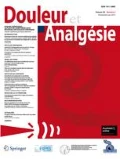Résumé
Bien que les substances opioïdes soient les analgésiques de référence pour prendre en charge les douleurs sévères, un certain nombre d’études expérimentales et cliniques indique qu’ils peuvent induire hyperalgésies et allodynies après l’effet analgésique et même faciliter le passage de la douleur aiguë à la douleur chronique. De nouvelles stratégies thérapeutiques que l’on peut qualifier d’antisensibilisation ou d’antihyperalgésie permettent d’améliorer l’efficacité des antalgiques opioïdes.
Abstract
Although opioids are unsurpassed analgesics, experimental and clinical studies show that opioid therapy designed to alleviate moderate to severe pain may unexpectedly render patients more sensitive to nociception (pain vulnerability) leading to hyperalgesia and allodynia and may facilitate the transition from acute to chronic pain. New therapeutic strategies referred to as antihypersensitivity or antihyperalgesic strategies have to be developed for improving the opioid use in patients.
Références
Angst MS, Clark JD (2006) Opioid-induced hyperalgesia: a qualitative systematic review. Anesthesiology 104:570–587
Bederson JB, Fields HL, Barbaro NM (1990) Hyperalgesia during naloxone-precipitated withdrawal from morphine is associated with increased on-cell activity in the rostral ventromedial medulla. Somatosens Mot Res 7:185–203
Bessiere B, Richebé P, Laboureyras E, et al (2007) Nitrous oxide (N(2)O) prevents latent pain sensitization and long-term anxietylike behavior in pain and opioid-experienced rats. Neuropharmacology 53:733–740
Breivik H, Collett B, Ventafridda V, et al (2006) Survey of chronic pain in Europe: prevalence, impact on daily life, and treatment. Eur J Pain 10:287–333
Campbell JN, Meyer RA (2006) Mechanisms of neuropathic pain. Neuron 52:77–92
Célèrier E, Laulin J, Larcher A, et al (1999) Evidence for opiateactivatedNMDAprocesses masking opiate analgesia in rats. Brain Res 847:18–25
Célèrier E, Laulin JP, Corcuff JB, et al (2001) Progressive enhancement of delayed hyperalgesia induced by repeated heroin administration: a sensitization process. J Neurosci 21:4074–4080
Célèrier E, Rivat C, Jun Y, et al (2000) Long-lasting hyperalgesia induced by fentanyl in rats: preventive effect of ketamine. Anesthesiology 92:465–472
Goldfarb J, Kaplan EI, Jenkins HR (1978) Interaction of morphine and naloxone in acute spinal cats. Neuropharmacology 17:569–575
Guignard B, Bossard AE, Coste C, et al (2000) Acute opioid tolerance: intraoperative remifentanil increases postoperative pain and morphine requirement. Anesthesiology 93:409–417
Kehlet H, Jensen TS, Woolf CJ (2006) Persistent post-surgical pain: risk factors and prevention. Lancet 367:1618–1625
Kim DH, Fields HL, Barbaro NM (1990) Morphine analgesia and acute physical dependence: rapid onset of two opposing, doserelated processes. Brain Res 516:37–40
Koppert W, Schmelz M (2007) The impact of opioid-induced hyperalgesia for postoperative pain. Best Pract Res Clin Anaesthesiol 21:65–83
Laboureyras E, Chateauraynaud J, Richebé P, Simonnet G (2009) Long-term pain vulnerability after surgery in rats: prevention by nefopam, an analgesic with antihyperalgesic properties. Anesth Analg 109:623–631
Laplantine F (1997) Anthropologie de la maladie. Bibliothèque scientifique Payot, Paris
Laulin JP, Célèrier E, Larcher A, et al (1999) Opiate tolerance to daily heroin administration: an apparent phenomenon associated with enhanced pain sensitivity. Neuroscience 89:631–636
Le Breton D (2006) Anthropologie de la douleur, Métailié
Le Bars D, Guilbaud G, Jurna I, Besson JM (1976) Differential effects of morphine on responses of dorsal horn lamina V type cells elicited by A and C fibre stimulation in the spinal cat. Brain Res 115:518–524
Le Roy C, Laboureyras E, Gavello-Baudy S, et al (2009) Abnormal hyperalgesia observed following fentanyl ultra low-dose administration reveals latent pain hypersensitivity induced by prior exposure to opioid-dependent stress in rats. (Soumis)
Mao J, Price DD, Mayer DJ (1994) Thermal hyperalgesia in association with the development of morphine tolerance in rats: roles of excitatory amino acid receptors and protein-kinase C. J Neurosci 14:2301–2312
Nesse RM (1999) Proximate and evolutionary studies of anxiety, stress and depression: synergy at the interface. Neurosci Biobehav Rev 23:895–903
Richebé P, Rivat C, Creton C, et al (2005) Nitrous oxide revisited: evidence for potent antihyperalgesic properties. Anesthesiology 103:845–854
Richebé P, Rivat C, Laulin JP, et al (2005) Ketamine improves the management of exaggerated postoperative pain observed in perioperative fentanyl-treated rats. Anesthesiology 102:421–428
Rivat C, Laboureyras E, Laulin JP, et al (2007) Non-nociceptive environmental stress induces hyperalgesia, not analgesia, in pain and opioid-experienced rats. Neuropsychopharmacology 32:2217–2228
Rivat C, Laulin JP, Corcuff JB, et al (2002) Fentanyl enhancement of carrageenan-induced long-lasting hyperalgesia in rats: prevention by the N-methyl-D-aspartate receptor antagonist ketamine. Anesthesiology 96:381–391
Rivat C, Richebé P, Laboureyras E, et al (2008) Polyamine deficient diet to relieve pain hypersensitivity. Pain 137:125–137
Siegel S (1976) Morphine analgesic tolerance: its situation specificity supports a Pavlovian conditioning model. Science 193:323–325
Simonin F, Schmitt M, Laulin JP, et al (2006) RF9, a potent and selective neuropeptide FF receptor antagonist, prevents opioidinduced tolerance associated with hyperalgesia. Proc Natl Acad Sci USA 103:466–471
Simonnet G, Le Moal M, Vulnerability to opioid tolerance, dependence, and addiction: an individual-centered versus drugcentered paradigm analysis. IASP Book (ed), Pharmacology of pain, chapter 19 “Pharmacology of tolerance, dependence and addiction”, (sous presse)
Solomon RL (1980) The opponent-process theory of acquired motivation: the costs of pleasure and the benefits of pain. Am Psychol 35:691–712
Solomon RL, Corbit JD (1974) An opponent-process theory of motivation. I. Temporal dynamics of affect. Psychol Rev 81: 119–145
Stewart WF, Ricci JA, Chee E, et al (2003) Lost productive time and cost due to common pain conditions in the US workforce. JAMA 290:2443–2454
Tirault M, Derrode N, Clevenot D, et al (2006) The effect of nefopam on morphine overconsumption induced by large-dose remifentanil during propofol anesthesia for major abdominal surgery. Anesth Analg 102:110–117
Woolf CJ, Salter MW (2000) Neuronal plasticity: increasing the gain in pain. Science 288:1765–1769
Author information
Authors and Affiliations
Corresponding author
About this article
Cite this article
Simonnet, G., Laboureyras, E. Les opioïdes: de l’analgésie à l’hyperalgésie. Des dogmes à réexaminer ?. Douleur analg 22, 216–228 (2009). https://doi.org/10.1007/s11724-009-0147-2
Received:
Accepted:
Published:
Issue Date:
DOI: https://doi.org/10.1007/s11724-009-0147-2

